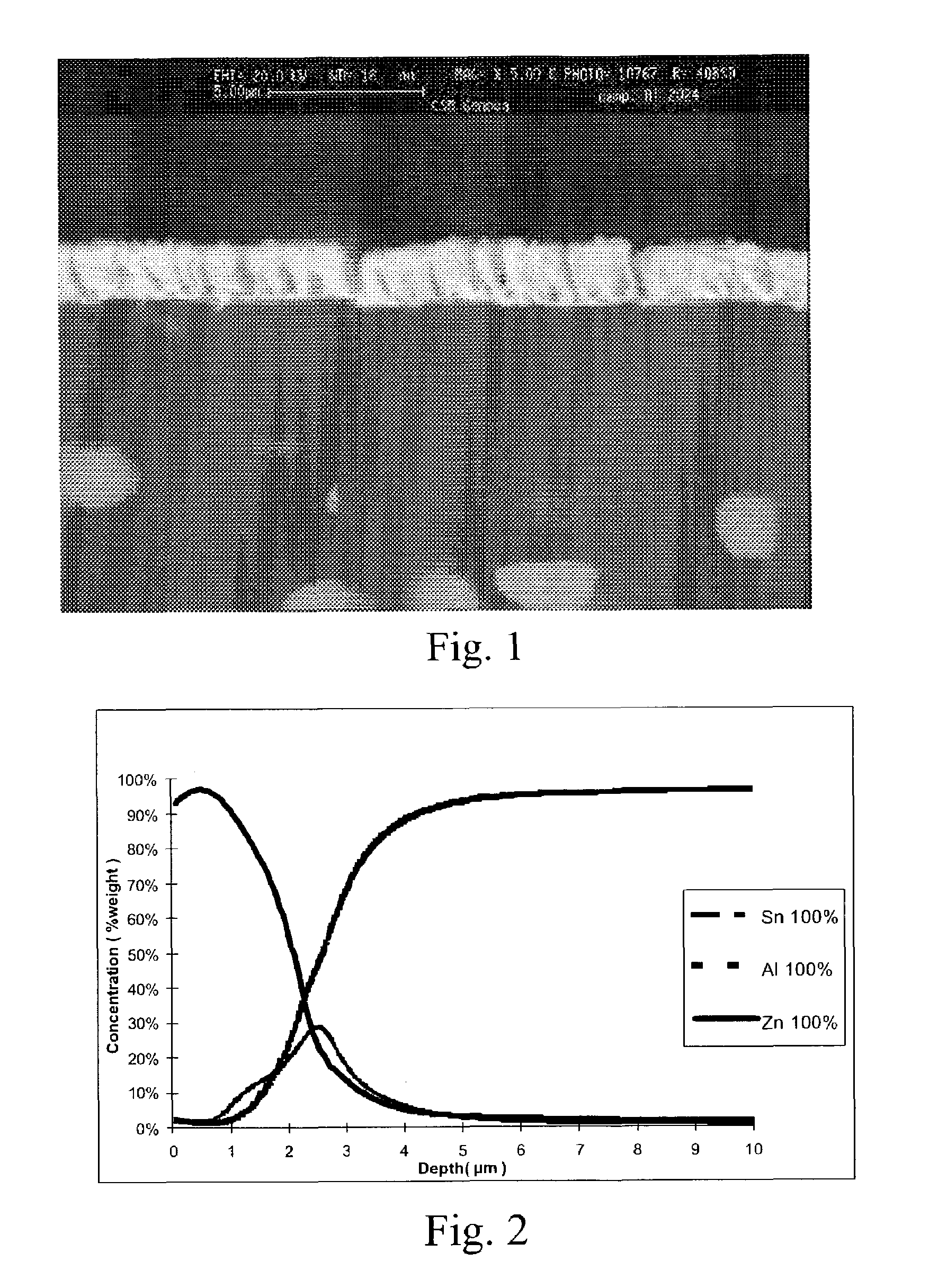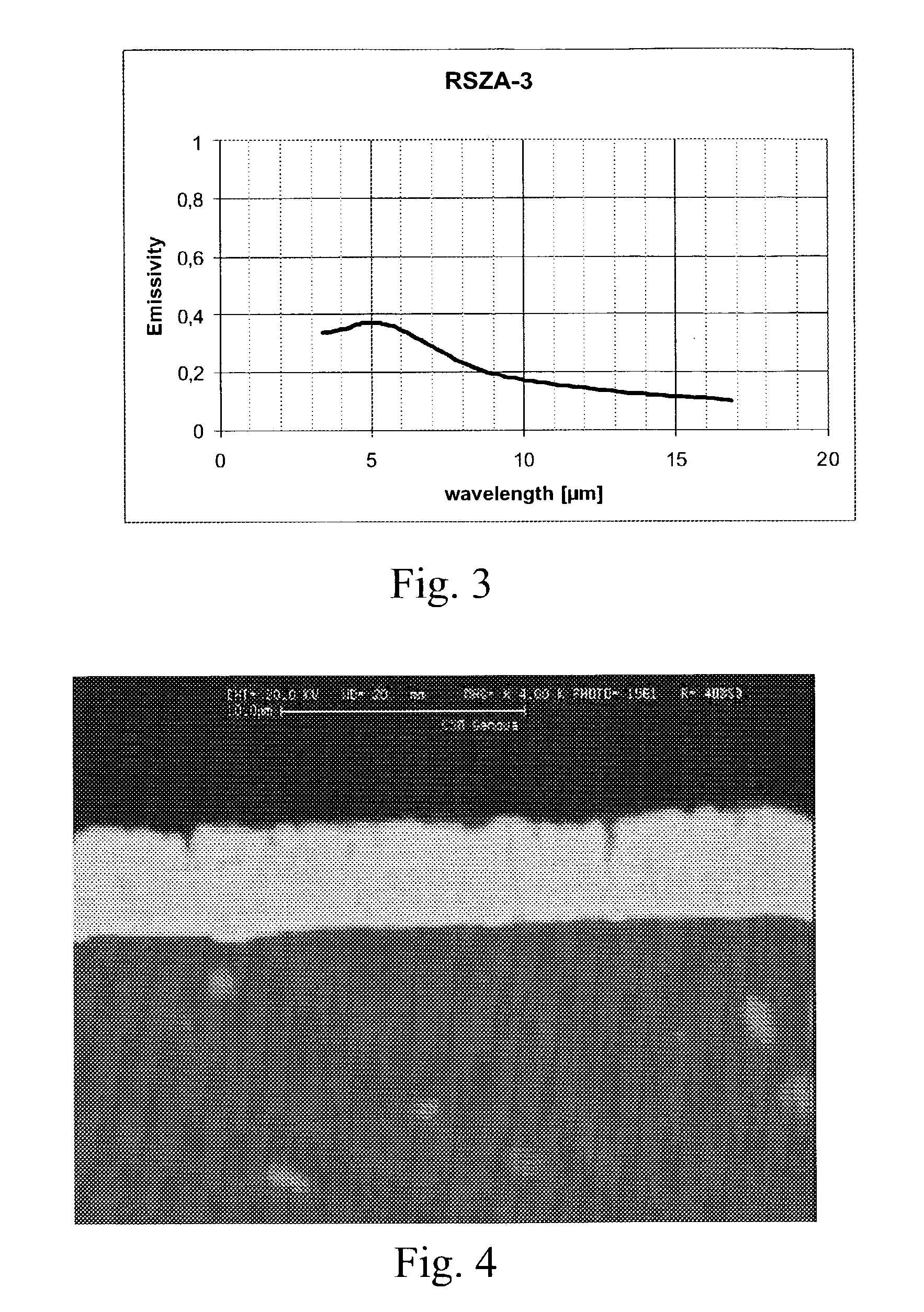Composite with a low emissivity in the medium and far infrared, and with a low reflectivity in the visible and near infrared
a technology of composite, which is applied in the field of composite with a low emissivity in the medium and far infrared, and with a low reflectivity in the visible and near infrared, can solve the problems of degrading the properties of varnishes, frequently reapplied, and unsatisfactory use of varnishes
- Summary
- Abstract
- Description
- Claims
- Application Information
AI Technical Summary
Benefits of technology
Problems solved by technology
Method used
Image
Examples
example 1
(Aluminum-Alloy-Based Product, with Zinc Oxide Coating, Doped with Aluminum (AZO) and an Intermediate Layer of Tin).
[0042]The product was obtained using a procedure that will be described in detail below, by employing the evaporation PVD technology. Such procedure was optimised considering three general conditions:[0043]Decrease in thickness, with the goal of diminishing the residual stresses;[0044]Deposition of the various layers without opening the deposition chamber;[0045]Process temperature kept well below 150° C. to prevent degradation of the mechanical properties of the base material.
[0046]The product was obtained using PVD evaporation technology as follows:[0047]Chemical cleaning of the base material[0048]Ion bombardment[0049]Deposition of three subsequent substrates of tin, zinc and aluminum in sequence, by keeping the chamber at low pressure; an electrical resistance evaporator was used for the zinc, while the tin and aluminum were evaporated using an EB (Electron Beam) ele...
example 2
(Aluminum-alloy-based Product, with Zinc Oxide Coating, Doped with Aluminum (AZO))
[0060]The product was obtained using a procedure that will be described in details below, employing the evaporation PVD technology. In this example as well, such procedure was optimised considering the three general conditions described in Example 1.
[0061]The product was obtained using the PVD evaporation technology as follows:[0062]Chemical cleaning of the base material[0063]Ion bombardment[0064]Deposition of a layer of zinc and aluminum; evaporated by using an electronic gun.
[0065]Table I shows the process parameters used for the deposition of the product described above, by alternating the beam's action on the two crucibles containing zinc and aluminum, so that a layer of a 97%-zinc-and-3%-aluminum alloy may be deposited.
[0066]Table III shows the process parameters used for the deposition of the product described above.
[0067]
TABLE IIIIon bombardmentDepositionTemper-Temper-CoatingTimeatureTimeatureEB...
example 3
(Aluminum-alloy-based Product, with Indium-oxide-based Coating, Doped with Tin (ITO) and Intermediate Layer of Tungsten Oxide)
[0074]The product was obtained as follows:[0075]Deposition, by using PVD sputtering, of a Tungsten Oxide layer (WO3);[0076]Deposition, by using PVD sputtering, of an Indium Oxide layer, doped with 10% of Tin (ITO).
[0077]Table V shows the process parameters used for the deposition of the two layers.
[0078]The attached FIG. 6FIG. 6 shows the emissivity in the infrared of the product shown in this example: the sample shows an average value lower than 0.2 in the mid- and far-infrared.
[0079]
TABLE VPotentialBiasDeposition TimeMaterial(V)(V)(minutes)WO36005.545ITO5505.520
[0080]To determine the optical properties in the visible and near-infrared, reflexivity measurements were taken on the product, the results of which are shown in the attached FIG. 7: the sample shows an average value lower than 0.2 in the visible and lower than 0.3 in the near infrared.
PUM
| Property | Measurement | Unit |
|---|---|---|
| wavelength | aaaaa | aaaaa |
| emissivity | aaaaa | aaaaa |
| thick | aaaaa | aaaaa |
Abstract
Description
Claims
Application Information
 Login to View More
Login to View More - R&D
- Intellectual Property
- Life Sciences
- Materials
- Tech Scout
- Unparalleled Data Quality
- Higher Quality Content
- 60% Fewer Hallucinations
Browse by: Latest US Patents, China's latest patents, Technical Efficacy Thesaurus, Application Domain, Technology Topic, Popular Technical Reports.
© 2025 PatSnap. All rights reserved.Legal|Privacy policy|Modern Slavery Act Transparency Statement|Sitemap|About US| Contact US: help@patsnap.com



